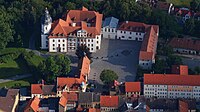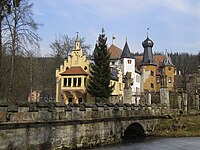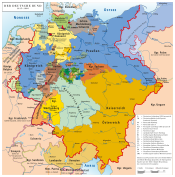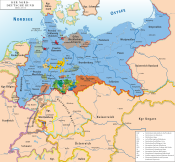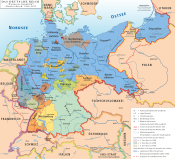Saxe-Altenburg
Duchy of Saxe-Altenburg(1602–1918) Herzogtum Sachsen-Altenburg Free State of Saxe-Altenburg(1918–1920) Freistaat Sachsen-Altenburg | |||||||||
|---|---|---|---|---|---|---|---|---|---|
| 1602–1672 1826–1920 | |||||||||
Flag[1]
| |||||||||
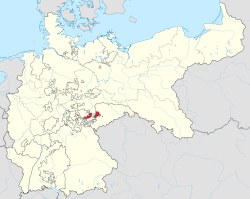 | |||||||||
| Status | Stateof theHoly Roman Empire, Stateof theGerman Confederation, Stateof theNorth German Confederation, Stateof theGerman Empire, Stateof theWeimar Republic | ||||||||
| Capital | Altenburg | ||||||||
| Common languages | German | ||||||||
| Religion | Roman Catholicism | ||||||||
| Government | Duchy(1602–1918) Republic(1918–1920) | ||||||||
| Duke | |||||||||
• 1603–1613 | Johann Philipp(first) | ||||||||
• 1908–1918 | Ernst II(last) | ||||||||
| History | |||||||||
•Saxe-Weimarpartitioned | 7 July 1602 | ||||||||
•Personal unionwithSaxe-Gotha* | 1672–1825 | ||||||||
•Ernestine duchiesrearranged, duchy restored | 12 November 1826 | ||||||||
| November 1918 | |||||||||
• Merger ofThuringia‡ | 1920 | ||||||||
| |||||||||
| Today part of | Germany | ||||||||
*SeeSaxe-Gotha-Altenburg † As Free State of Saxe-Altenburg ‡ In 1920, theex-Imperial statesof Saxe-Altenburg,Saxe-Meiningen,Saxe-Coburg-Gotha,Saxe-Weimar-Eisenach,Schwarzburg-Sondershausen,Schwarzburg-Rudolstadtand the two principalities ofReußall merged to form the Free State ofThuringia. | |||||||||
Saxe-Altenburg(‹See Tfd›German:Sachsen-Altenburg) was one of the Saxon duchies held by theErnestinebranch of theHouse of Wettinin present-dayThuringia.[2]It was one of the smallest of the German states with an area of 1323 square kilometers and a population of 207,000 (1905) of whom about one fifth resided in the capital,Altenburg.The territory of the duchy consisted of two non-contiguous territories separated by land belonging to thePrincipality of Reuss-Gera.Its economy was based on agriculture, forestry, and small industry. The state had a constitutional monarchical form of government with a parliament composed of thirty members chosen by male taxpayers over 25 years of age.
Territory
[edit]Saxe-Altenburg had an area of 1,323 km2(510 sq. mi.) and a population of 207,000 in 1905. Its capital wasAltenburg.
The duchy consisted of two separate areas: the Ostkreis, containing the cities ofAltenburg,Schmölln,Gößnitz,LuckaundMeuselwitz(including the exclave of Mumsdorf),Roschütz,Hilbersdorf,NeukirchenbyWaldenburgand Rußdorf byChemnitz;and the Westkreis, which contained the cities ofEisenberg,Kahla,OrlamündeundRoda(including the exclave of Ammelstädt). The Ostkreis roughly corresponds to the modernAltenburger Landdistrict of Thuringia, plus the area aroundRonneburginGreiz.The Westkreis is now mostly inSaale-Holzland district,with small portions in neighbouring districts. The duchy contained thePleißeandSaalerivers.
History
[edit]
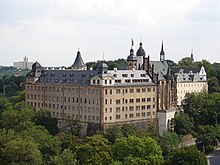
The duchy had its origins in the medieval Burgraviate ofAltenburgin the ImperialPleissnerland(Terra Plisensis),a possession of the WettinMargraves of Meissensince 1243. Following thepartition of Leipzigin 1485, Altenburg fell toErnst, Elector of Saxony,the progenitor of theErnestine Wettins.[3]After theCapitulation of Wittenbergin 1547, the area around Altenburg went to theAlbertineElectorate of Saxony,but it was transferred to the ErnestineDuchy of Saxonyin theTreaty of Naumburgin 1554, and then to the Duchy ofSaxe-Weimarfollowing thePartition of Erfurtin 1572.
When Johann Wilhelm's son and successorFriedrich Wilhelm Idied in 1602, the Duchy of Saxe-Weimar passed to his younger brotherJohann II.In 1603 Frederick William's eldest sonJohann Philippreceived the newly createdDuchy of Saxe-Altenburgas compensation. It was anImperial Statein its own right, with a vote in theReichstag,for much of the 17th century until the extinction of its ruling line in 1672 when it was inherited byErnest I the Pious,the Duke ofSaxe-Gotha,who had married the heiress.
Saxe-Altenburg thereafter remained part ofSaxe-Gotha-Altenburguntil the extinction of that house in 1825, when Gotha and Altenburg were divided up, with Gotha going to the Duke ofSaxe-Coburg-Saalfeldand Altenburg to the Duke ofSaxe-Hildburghausen,who in exchange gave up Hildburghausen to the Duke ofSaxe-Meiningen.This family ruled the duchy until the end of the monarchies in the course of theGerman Revolution of 1918–19.The succeedingFree State of Saxe-Altenburgwas incorporated into the new state ofThuringiain 1920.
Dukes of Saxe-Altenburg
[edit]Elder line
[edit]- Johann Philipp, Duke of Saxe-Altenburg(1603–1639)
- Friedrich Wilhelm II, Duke of Saxe-Altenburg(1639–1669)
- Friedrich Wilhelm III, Duke of Saxe-Altenburg(1669–1672)
Line extinct, inherited bySaxe-Gotha,thereuponSaxe-Gotha-Altenburg
Junior line
[edit]- Frederick, Duke of Saxe-Altenburg(1826–1834)(Previously Duke ofSaxe-Hildburghausen)
- Joseph, Duke of Saxe-Altenburg(1834–1848)
- Georg, Duke of Saxe-Altenburg(1848–1853)
- Ernst I, Duke of Saxe-Altenburg(1853–1908)
- Ernst II, Duke of Saxe-Altenburg(1908–1918)
Secondary residences of the Dukes of Saxe-Altenburg
[edit]-
Christiansburg Castle atEisenberg
-
WolfersdorfCastle
-
The Old Hunting Lodge atHummelshain
-
The New Hunting Lodge at Hummelshain
See also
[edit]Notes
[edit]- ^Thüringisches Staatsarchiv Altenburg (Hrsg.): Rautenkranz und rote Rose: Die Hoheitszeichen des Herzogtums und des Freistaates Sachsen Altenburg. Sax-Verlag, Altenburg, 2010.
- ^"The Ernestine Line's Saxon Duchies"(Web).Historical Atlas.Tacitus Historical Atlas.Retrieved2007-05-19.
- ^Herbermann, Charles, ed. (1913)..Catholic Encyclopedia.New York: Robert Appleton Company.
References
[edit]- Chisholm, Hugh,ed. (1911)..Encyclopædia Britannica(11th ed.). Cambridge University Press.
External links
[edit]- Dukes of Saxe-Altenburg
- 1602 establishments in the Holy Roman Empire
- Altenburg
- Ernestine duchies
- House of Wettin
- States and territories disestablished in 1918
- States and territories established in 1602
- States of the German Confederation
- States of the German Empire
- States of the North German Confederation
- States of the Weimar Republic




